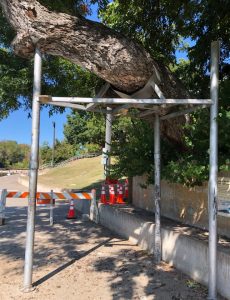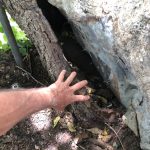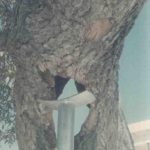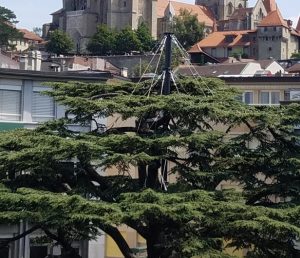
The beloved leaning pecan at Barton Springs Pool
The pecan tree that leans heavily over the Barton Springs Pool is scheduled for removal. As an arborist who has fought for the preservation of trees in Austin for over 40 years, I unfortunately must agree, it’s time to say goodbye. This iconic tree has been at high risk of failing for decades, its heavy lean first documented in historical photos from the 30’s. The city of Austin has done everything possible to physically support the tree, from using tar, concrete and rebar to fill the massive cavity in its trunk (where decay created a hollow large enough for a man to easily fit inside of it), to installing steel support posts, to anchoring support ropes to nearby structures. For decades it has been poked, prodded and even internally examined with high tech sonar equipment. Realizing its days were numbered, they even planted a replacement tree next to it in the 70’s.
The question on everyone’s mind of course is, “Can’t it be saved?” This is not the first time the question has arose in recent history. Surely back in the 40’s, 50’s and 70’s, when most of these materials were installed in the tree this question was asked. But it was asked again in 2009, when the city was planning to remove about 24 huge trees around the pool area, including this tree. In fact, this tree was one of four that received the highest risk rating out the 58 trees assessed at that time. But during public hearings regarding these trees, several other local arborists and I advocated for a more thorough assessment of most of the trees the city thought should be removed. It was my opinion that most of them would be deemed worthy of keeping after such an assessment. I did not think this tree was one that needed further assessment at that time as its condition was so obviously poor that it shouldn’t be kept.
The assessments were done, and only about four to six trees were removed over the following year or two, and the remainder of the 24 are still there, looking good. But public sentiment was so strong during the hearings that “Flo”, as it came to be called, was shored up with yet more steel supports, and then I guess everyone just crossed their fingers.
Now, indications of further decline have led the city to reevaluate Flo yet again. One of the most troubling indications is the recent appearance of a fungal structure that was identified by Texas A&M plant pathology lab as a decay fungi known as Kretzschmaria deusta. This serious decay fungi almost always leads to rapid, total root failure or tree death. This, and the widening of the separation between what little remains of actual trunk tissue and the massive concrete filling (first installed over a half century ago and then replaced again years later- see photos) led the city to acquire reports from three of the city’s most experienced tree care companies.

separation of trunk from filling 2023

city of austin photo from the 70’s

city of austin photos from the 70’sled the city to have an in-depth assessment done by three of the city’s most respected arborists.
Meanwhile, the head of a prominent local environmental group (Save Our Springs) also asked me to look at the tree. I explained to him that the tree was in worse shape than in 2009 and the best course of action was removal. Despite valuing my opinion as an expert in tree care for over twenty years, he was adamant that I was “missing the point” about the tree’s condition.
After the other city-ordered reports were done, the city was asked by several concerned citizens if they would have me also look at the tree. I told the city that as my opinion of the tree from 14 years earlier hadn’t changed, and that they had these other reports documenting its condition, I would provide a more basic assessment and put my opinion and recommendation to remove in writing. It turned out my opinion was in agreement with the three other arborists. The city has put our reports on their website. They also got “off the record” recommendations from two other arborists with decades of local experience concurring with the four of us.
Then SOS did an odd thing. Despite the leader repeatedly telling me during our discussions that this was “an engineering issue, not an arborist one”, he then asked another arborist to provide his opinion! This arborist stated that he does not have the experience and training to properly assess what level of risk the tree poses.
So SOS published a public notice in which they state that this other arborist was “the only one” of the arborists who looked at the tree to “acknowledge” that he does not have the expertise to assess it, thereby implying that I and the other arborists hired by the city (who have a collective 100+ years of local experience) are lying about our qualifications. Could it be that this other arborist just didn’t want to make an enemy of a prominent group of environmentalists? Or maybe he truly just doesn’t have the expertise (despite touting his extensive experience for years). Either way, I can assure you, the four of us who rendered an opinion definitely have the expertise to have done so, especially whereas the trees condition is so obviously poor that even a journeyman arborist could have made the call.
There are dozens of photos on the city website that show this. Yes, it has a lush green canopy of leaves, but this has nothing to do with a tree’s structural integrity (see my post on tree decay). In fact, in an urban environment it’s usually a tree with a full green canopy that topples, and is found to be totally rotten inside. The dead and dying ones are often cut down before they fall.
While it is possible to add even more steel support posts and cables to truss up even more of the tree (like this cedar in Switzerland) it would still be necessary to  construct some kind of barricade to keep people out from under it should part of it fall, and this would mean a permanent structure of some kind in the pool itself. This would obstruct part of the pool and pose a significant obstacle and possible hazard to swimmers.
construct some kind of barricade to keep people out from under it should part of it fall, and this would mean a permanent structure of some kind in the pool itself. This would obstruct part of the pool and pose a significant obstacle and possible hazard to swimmers.
If the city decided to do those things, and something still happened, it would be hard for the city to justify having kept the tree in light of its condition. To put it mildly. I wonder if the leader of SOS (a lawyer), would rush to defend the city from such a lawsuit. And after $100K is likely spent, (one off the record estimate was five times that) the tree will still die from root rot, probably within five years according to some of the experts.
The city has done an amazing job (and endured significant liability risk in my opinion) to keep this tree for the more than 50 years that it has been in poor condition. Again, I must agree, it’s time to eliminate this risk.
